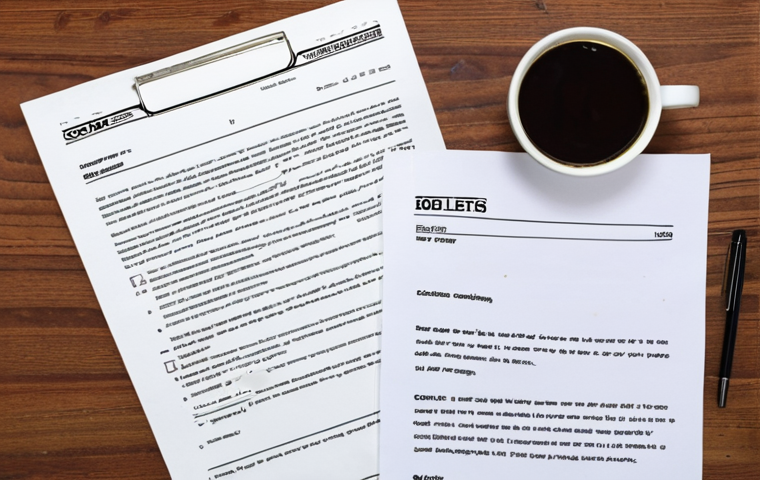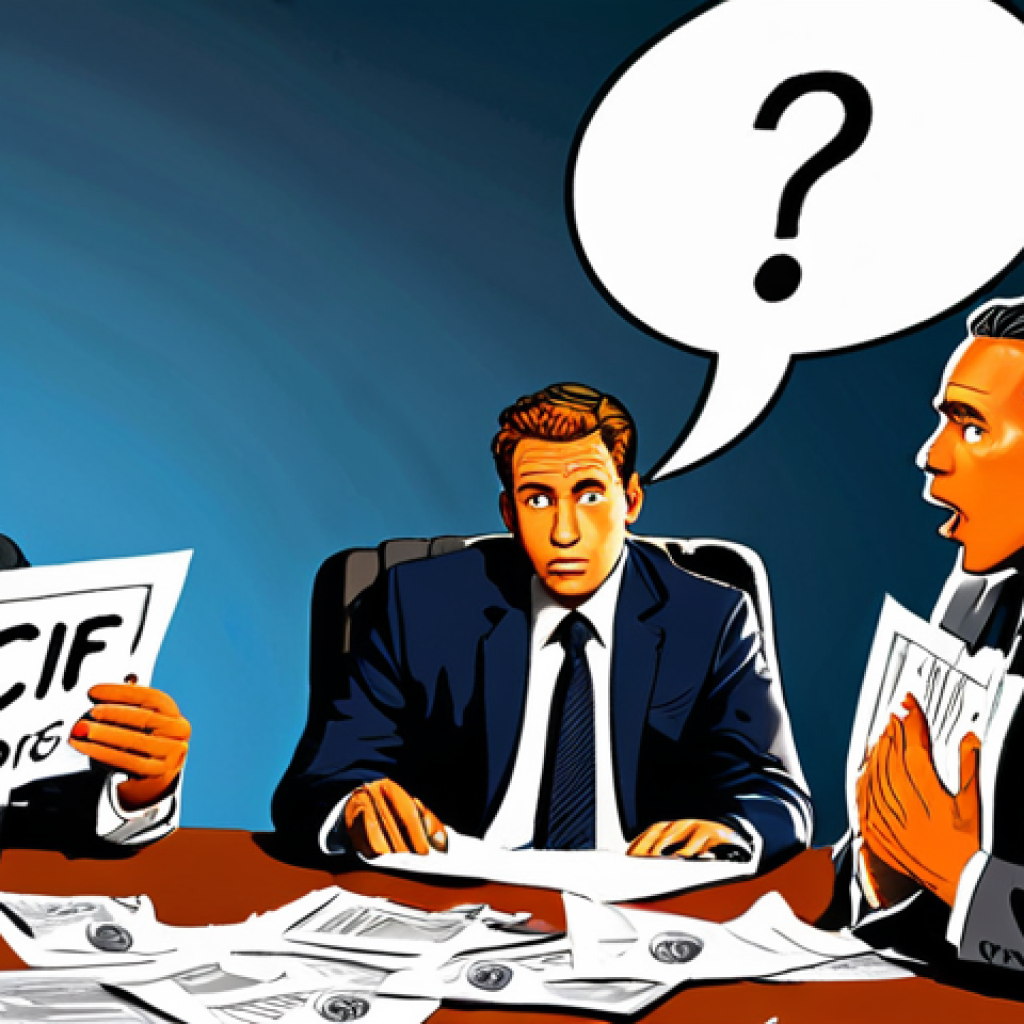So, you’re diving into the world of international trade and need to ace that dreaded trade English exam? I remember sweating over those practice questions, feeling like I was deciphering an ancient language instead of business communication.
But trust me, with the right resources, you can conquer it. Now that the world increasingly demands smooth global interactions, excelling in trade English isn’t just about passing a test; it’s about opening doors to real-world opportunities and global career advancement.
Lately, I’ve noticed more emphasis on practical application in these exams, reflecting the shift towards AI-powered translation tools and the need for nuanced human understanding.
Let’s explore this in more detail down below!
Alright, buckle up – let’s get you prepped to ace that trade English exam!
Decoding Common Trade Terminology

It’s funny, isn’t it? We throw around terms like “CIF” or “L/C” in business meetings, assuming everyone’s on the same page. But the devil’s in the details.
I remember once negotiating a deal where the buyer and seller had completely different understandings of “Incoterms.” The whole thing almost fell apart because of a simple miscommunication.
In trade English, it’s not just about knowing the words; it’s about understanding the nuances behind them. For instance, I was helping a friend navigate his new import business, and he kept mixing up “duty” and “tariff.” It led to some serious miscalculations in his costing.
He learned the hard way that attention to detail in terminology can save you a lot of money!
Navigating Incoterms
Incoterms—the International Commercial Terms—are those ubiquitous three-letter codes that define responsibilities between buyers and sellers. EXW (Ex Works), FOB (Free on Board), CIF (Cost, Insurance, and Freight) – they sound simple enough, right?
I once had a colleague who thought FOB meant the seller was responsible until the goods arrived at the buyer’s warehouse. You can imagine the shock when he found out his responsibility ended once the goods were on board the ship!
Knowing these terms inside and out is crucial, especially when negotiating contracts.
Mastering Payment Methods
From Letters of Credit (L/C) to documentary collections and open accounts, choosing the right payment method can make or break a deal. When I started out, I thought an L/C was just a formality.
I didn’t realize how much protection it offered until a buyer in a new market tried to back out of a deal. The L/C saved the day, ensuring I got paid even when things got complicated.
Secure payment methods are critical for mitigating risk in international transactions, especially with unfamiliar partners.
Understanding Compliance and Regulations
Trade compliance is a minefield of regulations, tariffs, quotas, and export controls. It is critical for avoiding severe penalties. I once consulted with a company that unknowingly violated export regulations by shipping goods to a restricted country through an intermediary.
The fines were astronomical, and it took them months to sort everything out. Staying up-to-date with the latest trade laws is essential to avoid compliance issues.
Sharpening Your Writing Skills for Trade
Effective communication is the lifeblood of international trade. You might have the best product in the world, but if you can’t articulate its value clearly, you’ll struggle to make sales.
I once reviewed a sales email from a supplier that was so poorly written, it was almost comical. It was full of grammatical errors, vague language, and irrelevant information.
No surprise they weren’t getting any responses! Polished writing builds credibility and confidence, which is essential for closing deals and building lasting relationships.
Crafting Persuasive Sales Letters
Sales letters are your opportunity to grab a potential buyer’s attention and convince them your product or service is worth their investment. I remember receiving a sales letter that was so generic, it could have been selling anything from widgets to space shuttles.
It didn’t address my specific needs or offer any compelling reasons to choose their company over the competition. A strong sales letter is targeted, concise, and highlights the unique value proposition of your offering.
Writing Clear and Concise Contracts
Contracts are the foundation of any trade agreement, so it is crucial that they are clear, unambiguous, and legally sound. I once saw a contract that was so convoluted, it took a team of lawyers weeks to decipher it.
By the time they understood the terms, the deal had fallen apart! Simplicity and precision are key. Avoid jargon, define key terms, and ensure all obligations are clearly stated.
Producing Effective Trade Documentation
From commercial invoices to packing lists and certificates of origin, trade documentation is the lifeblood of international shipments. I learned this the hard way.
My first international shipment was delayed for weeks because I filled out the customs forms incorrectly. The delay cost me money, frustrated my customer, and damaged my reputation.
Accuracy, completeness, and consistency are essential for smooth customs clearance.
The Role of Cultural Sensitivity in Trade Communication
I learned the importance of cultural sensitivity while dealing with a client in Japan. I made the mistake of being overly direct in my communication, which came across as aggressive and disrespectful.
It took me a while to rebuild trust and repair the relationship. In international trade, cultural awareness is essential for building rapport, avoiding misunderstandings, and fostering long-term partnerships.
Understanding Nonverbal Communication
Gestures, body language, and facial expressions can vary significantly across cultures. A simple nod of the head that means “yes” in one culture might mean “no” in another.
I was in a meeting in the Middle East once, and I mistakenly crossed my legs, showing the sole of my shoe to my host. It was considered incredibly rude, and I didn’t realize it until someone discreetly pointed it out to me later.
Being mindful of nonverbal cues can help you avoid unintentional insults and build stronger relationships.
Adapting Communication Styles
Some cultures value directness and brevity, while others prefer indirectness and formality. I once worked with a client in South Korea who always started our meetings with small talk and relationship-building before diving into business.
At first, I was impatient, but I soon realized it was an essential part of their culture. Adapting your communication style to your audience’s preferences shows respect and builds trust.
Navigating Language Barriers
Even if you’re fluent in English, language barriers can still exist. Slang, idioms, and colloquialisms can be confusing or misinterpreted by non-native speakers.
I always try to use clear, simple language and avoid jargon when communicating with international partners. It’s also helpful to confirm understanding by asking clarifying questions and summarizing key points.
Leveraging Technology for Trade English Proficiency
In today’s digital age, technology can be a powerful tool for improving your trade English skills. From online courses to translation apps and virtual reality simulations, there are endless opportunities to learn and practice.
I’ve found that using online resources like industry-specific podcasts and webinars can expose you to the real-world language used in global business, improving your overall comprehension and fluency.
Utilizing Online Resources
There are tons of websites, apps, and online courses dedicated to teaching trade English. I found some interactive platforms where you can practice writing emails, negotiating contracts, and giving presentations in a virtual environment.
These resources provide valuable feedback and help you identify areas where you need to improve.
Harnessing Translation Tools
While not a substitute for learning the language, translation apps can be helpful in a pinch. I used Google Translate to quickly understand complex documents or communicate with someone who doesn’t speak English fluently.
However, always double-check the accuracy of the translation, as these tools are not always perfect.
Exploring Virtual Reality Simulations
VR simulations can provide immersive, real-world practice in trade English. Some programs allow you to participate in virtual trade shows, negotiate contracts with virtual clients, and even present your product to a virtual audience.
These simulations can help you build confidence and improve your communication skills in a realistic setting.
| Aspect | Description | Importance |
|---|---|---|
| Terminology | Understanding key trade terms like Incoterms and payment methods | Essential for accurate communication and avoiding misunderstandings |
| Writing Skills | Crafting persuasive sales letters, clear contracts, and effective documentation | Critical for building credibility and closing deals |
| Cultural Sensitivity | Adapting communication styles, understanding nonverbal cues, and navigating language barriers | Vital for building rapport and fostering long-term partnerships |
| Technology | Leveraging online resources, translation tools, and VR simulations | Provides opportunities for learning, practicing, and improving trade English skills |
Maximizing Your Study Efficiency
Preparing for a trade English exam can feel overwhelming, but with the right strategies, you can maximize your study efficiency and achieve your goals.
I used to try to cram everything in at the last minute, which was always stressful and ineffective. I learned that consistent, focused study is much more effective than sporadic, intense sessions.
Setting Realistic Goals
Break down the exam into smaller, manageable chunks. I like setting daily or weekly goals, such as learning a certain number of new terms or practicing a specific writing skill.
Celebrating small victories along the way can keep you motivated and on track.
Using Active Recall
Instead of passively reading through textbooks, try using active recall techniques. I find that flashcards are great for memorizing key terms and concepts.
Also, try summarizing what you’ve learned in your own words, or teaching it to someone else.
Practicing with Mock Exams
The best way to prepare for an exam is to practice with mock exams. This helps you get familiar with the format, identify your weaknesses, and build your confidence.
There are tons of practice tests available online, or you can create your own by using old exam questions. I hope that gives you a solid foundation for prepping for your trade English exam!
Alright, buckle up – let’s get you prepped to ace that trade English exam!
Decoding Common Trade Terminology
It’s funny, isn’t it? We throw around terms like “CIF” or “L/C” in business meetings, assuming everyone’s on the same page. But the devil’s in the details. I remember once negotiating a deal where the buyer and seller had completely different understandings of “Incoterms.” The whole thing almost fell apart because of a simple miscommunication. In trade English, it’s not just about knowing the words; it’s about understanding the nuances behind them. For instance, I was helping a friend navigate his new import business, and he kept mixing up “duty” and “tariff.” It led to some serious miscalculations in his costing. He learned the hard way that attention to detail in terminology can save you a lot of money!
Navigating Incoterms
Incoterms—the International Commercial Terms—are those ubiquitous three-letter codes that define responsibilities between buyers and sellers. EXW (Ex Works), FOB (Free on Board), CIF (Cost, Insurance, and Freight) – they sound simple enough, right? I once had a colleague who thought FOB meant the seller was responsible until the goods arrived at the buyer’s warehouse. You can imagine the shock when he found out his responsibility ended once the goods were on board the ship! Knowing these terms inside and out is crucial, especially when negotiating contracts.
Mastering Payment Methods
From Letters of Credit (L/C) to documentary collections and open accounts, choosing the right payment method can make or break a deal. When I started out, I thought an L/C was just a formality. I didn’t realize how much protection it offered until a buyer in a new market tried to back out of a deal. The L/C saved the day, ensuring I got paid even when things got complicated. Secure payment methods are critical for mitigating risk in international transactions, especially with unfamiliar partners.
Understanding Compliance and Regulations
Trade compliance is a minefield of regulations, tariffs, quotas, and export controls. It is critical for avoiding severe penalties. I once consulted with a company that unknowingly violated export regulations by shipping goods to a restricted country through an intermediary. The fines were astronomical, and it took them months to sort everything out. Staying up-to-date with the latest trade laws is essential to avoid compliance issues.
Sharpening Your Writing Skills for Trade
Effective communication is the lifeblood of international trade. You might have the best product in the world, but if you can’t articulate its value clearly, you’ll struggle to make sales. I once reviewed a sales email from a supplier that was so poorly written, it was almost comical. It was full of grammatical errors, vague language, and irrelevant information. No surprise they weren’t getting any responses! Polished writing builds credibility and confidence, which is essential for closing deals and building lasting relationships.
Crafting Persuasive Sales Letters
Sales letters are your opportunity to grab a potential buyer’s attention and convince them your product or service is worth their investment. I remember receiving a sales letter that was so generic, it could have been selling anything from widgets to space shuttles. It didn’t address my specific needs or offer any compelling reasons to choose their company over the competition. A strong sales letter is targeted, concise, and highlights the unique value proposition of your offering.
Writing Clear and Concise Contracts
Contracts are the foundation of any trade agreement, so it is crucial that they are clear, unambiguous, and legally sound. I once saw a contract that was so convoluted, it took a team of lawyers weeks to decipher it. By the time they understood the terms, the deal had fallen apart! Simplicity and precision are key. Avoid jargon, define key terms, and ensure all obligations are clearly stated.
Producing Effective Trade Documentation
From commercial invoices to packing lists and certificates of origin, trade documentation is the lifeblood of international shipments. I learned this the hard way. My first international shipment was delayed for weeks because I filled out the customs forms incorrectly. The delay cost me money, frustrated my customer, and damaged my reputation. Accuracy, completeness, and consistency are essential for smooth customs clearance.
The Role of Cultural Sensitivity in Trade Communication
I learned the importance of cultural sensitivity while dealing with a client in Japan. I made the mistake of being overly direct in my communication, which came across as aggressive and disrespectful. It took me a while to rebuild trust and repair the relationship. In international trade, cultural awareness is essential for building rapport, avoiding misunderstandings, and fostering long-term partnerships.
Understanding Nonverbal Communication
Gestures, body language, and facial expressions can vary significantly across cultures. A simple nod of the head that means “yes” in one culture might mean “no” in another. I was in a meeting in the Middle East once, and I mistakenly crossed my legs, showing the sole of my shoe to my host. It was considered incredibly rude, and I didn’t realize it until someone discreetly pointed it out to me later. Being mindful of nonverbal cues can help you avoid unintentional insults and build stronger relationships.
Adapting Communication Styles
Some cultures value directness and brevity, while others prefer indirectness and formality. I once worked with a client in South Korea who always started our meetings with small talk and relationship-building before diving into business. At first, I was impatient, but I soon realized it was an essential part of their culture. Adapting your communication style to your audience’s preferences shows respect and builds trust.
Navigating Language Barriers
Even if you’re fluent in English, language barriers can still exist. Slang, idioms, and colloquialisms can be confusing or misinterpreted by non-native speakers. I always try to use clear, simple language and avoid jargon when communicating with international partners. It’s also helpful to confirm understanding by asking clarifying questions and summarizing key points.
Leveraging Technology for Trade English Proficiency
In today’s digital age, technology can be a powerful tool for improving your trade English skills. From online courses to translation apps and virtual reality simulations, there are endless opportunities to learn and practice. I’ve found that using online resources like industry-specific podcasts and webinars can expose you to the real-world language used in global business, improving your overall comprehension and fluency.
Utilizing Online Resources
There are tons of websites, apps, and online courses dedicated to teaching trade English. I found some interactive platforms where you can practice writing emails, negotiating contracts, and giving presentations in a virtual environment. These resources provide valuable feedback and help you identify areas where you need to improve.
Harnessing Translation Tools
While not a substitute for learning the language, translation apps can be helpful in a pinch. I used Google Translate to quickly understand complex documents or communicate with someone who doesn’t speak English fluently. However, always double-check the accuracy of the translation, as these tools are not always perfect.
Exploring Virtual Reality Simulations
VR simulations can provide immersive, real-world practice in trade English. Some programs allow you to participate in virtual trade shows, negotiate contracts with virtual clients, and even present your product to a virtual audience. These simulations can help you build confidence and improve your communication skills in a realistic setting.
| Aspect | Description | Importance |
|---|---|---|
| Terminology | Understanding key trade terms like Incoterms and payment methods | Essential for accurate communication and avoiding misunderstandings |
| Writing Skills | Crafting persuasive sales letters, clear contracts, and effective documentation | Critical for building credibility and closing deals |
| Cultural Sensitivity | Adapting communication styles, understanding nonverbal cues, and navigating language barriers | Vital for building rapport and fostering long-term partnerships |
| Technology | Leveraging online resources, translation tools, and VR simulations | Provides opportunities for learning, practicing, and improving trade English skills |
Maximizing Your Study Efficiency
Preparing for a trade English exam can feel overwhelming, but with the right strategies, you can maximize your study efficiency and achieve your goals. I used to try to cram everything in at the last minute, which was always stressful and ineffective. I learned that consistent, focused study is much more effective than sporadic, intense sessions.
Setting Realistic Goals
Break down the exam into smaller, manageable chunks. I like setting daily or weekly goals, such as learning a certain number of new terms or practicing a specific writing skill. Celebrating small victories along the way can keep you motivated and on track.
Using Active Recall
Instead of passively reading through textbooks, try using active recall techniques. I find that flashcards are great for memorizing key terms and concepts. Also, try summarizing what you’ve learned in your own words, or teaching it to someone else.
Practicing with Mock Exams
The best way to prepare for an exam is to practice with mock exams. This helps you get familiar with the format, identify your weaknesses, and build your confidence. There are tons of practice tests available online, or you can create your own by using old exam questions.
In Conclusion
So, there you have it! Mastering trade English is a journey that combines linguistic proficiency, cultural awareness, and strategic study habits. Embrace the challenge, leverage the resources available to you, and remember that every step you take towards improving your skills will open doors to new opportunities in the global marketplace. Good luck with your exam!
Useful Tips to Remember
1. Invest in a good quality trade English dictionary and keep it handy.
2. Subscribe to trade publications and newsletters to stay updated on industry jargon.
3. Join online forums or communities of trade professionals to practice your English.
4. Watch documentaries or interviews related to international trade to improve listening comprehension.
5. Consider hiring a trade English tutor for personalized guidance and feedback.
Key Takeaways
• Terminology: Understand and use trade-specific terms correctly.
• Writing: Practice writing clear and effective sales letters and contracts.
• Culture: Develop cultural sensitivity and adapt your communication style.
• Technology: Utilize online resources and translation tools to enhance learning.
• Study Habits: Set realistic goals, use active recall, and practice with mock exams.
Frequently Asked Questions (FAQ) 📖
Q: I’m completely new to trade English. Where do I even start preparing for the exam?
A: Honestly, don’t panic! A solid starting point is familiarizing yourself with common trade terminology. Think Incoterms (those confusing delivery agreements!), payment methods like Letters of Credit, and basic import/export documentation.
Many online resources offer free glossaries and practice quizzes. I actually found success starting with Investopedia’s trade terms section. Also, try immersing yourself in authentic trade-related content.
I personally found reading articles in the Financial Times, especially those covering international business and trade agreements, super helpful in picking up the vocabulary and understanding the context.
It’s like learning a language – you have to hear and see it in action!
Q: What’s the most challenging aspect of the trade English exam, and how can I overcome it?
A: In my experience, the trickiest part is understanding the nuances and implied meanings in trade-related communication. It’s not just about knowing the definitions; it’s about understanding how those terms are used in real-world scenarios and how cultural differences might affect communication.
So, don’t just memorize definitions. Practice analyzing case studies or simulated trade scenarios. I remember struggling with interpreting emails between different parties involved in a transaction.
My strategy was to actively seek out those kinds of examples. Also, role-playing with a friend who understands trade is invaluable. Being able to act out different situations is a great way to test your understanding!
Plus, many exams use slightly indirect phrasings to test your real understanding, so practice is key.
Q: Are there any specific resources or study materials you’d recommend to maximize my chances of success?
A: Absolutely! Beyond the free online glossaries and news articles, consider investing in a good trade English textbook or a specialized course. I know they can be pricey, but some community colleges offer affordable trade English courses.
These courses often provide structured lessons, practice exams, and feedback on your writing and speaking skills. I personally found the “International Trade: An Essential Guide to the Principles and Practice” book helpful, though it’s a bit dry.
Look for sample exam papers online; many organizations offer them for free or a small fee. Actively participating in online forums or study groups can also be beneficial.
I really enjoyed a LinkedIn group dedicated to trade, where you can see real-world examples of professionals in global business settings. It’s a great place to ask questions and learn from other people’s experiences!
📚 References
Wikipedia Encyclopedia
구글 검색 결과
구글 검색 결과
구글 검색 결과
구글 검색 결과
구글 검색 결과






